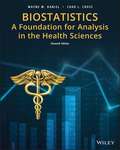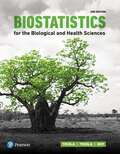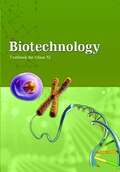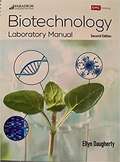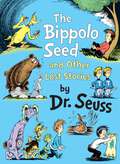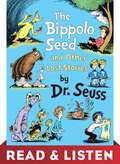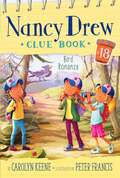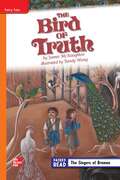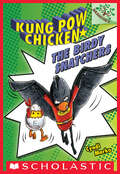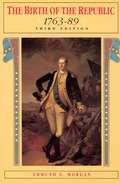- Table View
- List View
Biostatistics: A Foundation For Analysis In The Health Sciences
by Wayne W. Daniel Chad L. CrossThe ability to analyze and interpret enormous amounts of data has become a prerequisite for success in allied healthcare and the health sciences. Now in its 11th edition, Biostatistics: A Foundation for Analysis in the Health Sciences continues to offer in-depth guidance toward biostatistical concepts, techniques, and practical applications in the modern healthcare setting. Comprehensive in scope yet detailed in coverage, this text helps students understand—and appropriately use—probability distributions, sampling distributions, estimation, hypothesis testing, variance analysis, regression, correlation analysis, and other statistical tools fundamental to the science and practice of medicine.
Biostatistics for The Biological and Health Sciences
by Marc M. Triola Mario F. Triola Jason RoyReal-world applications connect statistical concepts to everyday life. This book uses a variety of real-world applications to bring statistical theories and methods to life. Through these examples and a friendly writing style, the 2nd Edition ensures that you understand concepts and develop skills in critical thinking, technology, and communication. The result of collaboration between a biological sciences expert and the author of the #1 statistics book in the country, Biostatistics for the Biological and Health Sciences provides an excellent introduction to statistics for readers interested in the biological, life, medical, and health sciences.
Biotechnology: A Laboratory Skills Course
by J. Kirk BrownA general survey of knowledge and techniques needed to function in a biotechnology lab.
Biotechnology: Science for the New Millennium
by Ellyn DaughertyThe new edition of Biotechnology: Science for the New Millennium is the perfect textbook and lab manual combination program for your classroom! Designed for introductory courses, this complete program teaches the concepts and hands-on lab procedures required for entry-level careers in the rapidly growing biotechnology industry. The textbook and lab manual can be used together or separately, depending on the desired course format.
Biotechnology: Science for the New Millennium
by Ellyn DaughertyThis complete program teaches the concepts and hands-on lab procedures required for entry-level careers in the rapidly growing biotechnology industry. The textbook and lab manual can be used together or separately, depending on the desired course format.
Biotechnology class 11 - NCERT - 23
by National Council of Educational Research and Training"Biotechnology" is a class 11 textbook following the NCERT syllabus. It introduces students to the principles and applications of biotechnology, covering genetic engineering, biomolecules, and cell biology. Topics include techniques like PCR and gene editing, applications in agriculture and medicine, and environmental conservation. The book also emphasizes ethics, safety, and the societal impact of biotechnology. With real-life examples, it encourages critical thinking and understanding of biotech's role in addressing global challenges. Ideal for Class 11 students, this comprehensive yet concise textbook aims to inspire the next generation of biotechnologists, providing a solid foundation for their academic journey and future contributions to the field.
Biotechnology Laboratory Manual
by Ellyn DaughertyBiotechnology Laboratory Manual Second Edition by Ellyn Daugherty
The Bippolo Seed and Other Lost Stories (Classic Seuss)
by Dr. SeussWhat&’s better than a lost treasure? Seven lost treasures! These rarely seen Dr. Seuss stories were published in magazines in the early 1950s and are finally available in book form. They include &“The Bippolo Seed&” (in which a scheming feline leads a duck toward a bad decision), &“The Rabbit, the Bear, and the Zinniga-Zanniga&” (about a rabbit who is saved from a bear by a single eyelash), &“Gustav, the Goldfish&” (an early rhymed version of the Beginner Book A Fish Out of Water), &“Tadd and Todd&” (about a twin who is striving to be an individual), &“Steak for Supper&” (in which fantastic creatures follow a boy home in anticipation of a steak dinner), &“The Strange Shirt Spot&” (the inspiration for the bathtub-ring scene in The Cat in the Hat Comes Back), and &“The Great Henry McBride&” (about a boy whose far-flung career fantasies are bested only by those of Dr. Seuss himself). An introduction by Seuss scholar Charles D. Cohen traces the history of the stories, which demonstrate an intentional move toward the writing style we now associate with Dr. Seuss. Cohen also explores the themes that recur in well-known Seuss stories (like the importance of the imagination or the perils of greed). With a color palette enhanced beyond the limitations of the original magazines, this is a collection that no Seuss fan (whether scholar or second grader) will want to miss.
The Bippolo Seed and Other Lost Stories: Read & Listen Edition (Classic Seuss)
by Dr. SeussWhat&’s better than a lost treasure? Seven lost treasures! These rarely seen Dr. Seuss stories were published in magazines in the early 1950s and are finally available in book form. They include &“The Bippolo Seed&” (in which a scheming feline leads a duck toward a bad decision), &“The Rabbit, the Bear, and the Zinniga-Zanniga&” (about a rabbit who is saved from a bear by a single eyelash), &“Gustav, the Goldfish&” (an early rhymed version of the Beginner Book A Fish Out of Water), &“Tadd and Todd&” (about a twin who is striving to be an individual), &“Steak for Supper&” (in which fantastic creatures follow a boy home in anticipation of a steak dinner), &“The Strange Shirt Spot&” (the inspiration for the bathtub-ring scene in The Cat in the Hat Comes Back), and &“The Great Henry McBride&” (about a boy whose far-flung career fantasies are bested only by those of Dr. Seuss himself). An introduction by Seuss scholar Charles D. Cohen traces the history of the stories, which demonstrate an intentional move toward the writing style we now associate with Dr. Seuss. Cohen also explores the themes that recur in well-known Seuss stories (like the importance of the imagination or the perils of greed). With a color palette enhanced beyond the limitations of the original magazines, this is a collection that no Seuss fan (whether scholar or second grader) will want to miss.This Read & Listen edition contains audio narration.
Bird Bonanza (Nancy Drew Clue Book #18)
by Carolyn KeeneNancy and her friends must unearth the person who sabotaged the River Heights Nature Park&’s fundraiser in the eighteenth book in the interactive Nancy Drew Clue Book mystery series.Nancy, Bess, and George are excited to be attending Bird Bonanza Camp. They&’ll spend their time learning all about different kinds of birds and taking part in fun crafts and activities. The highlight of the week is the Great Bird Count, an event where local bird watchers and ornithologists catalog every bird they see to help keep track of the health of the area&’s bird population. George is especially excited because one lucky participant will win a pair of PowerTron 5000s, binoculars so strong you can practically see to the moon! But when someone breaks into a greenhouse and destroys the plants being kept there, the girls suddenly have a new case. The park was planning to sell the now-ruined bird-friendly flowers and shrubs to help fund their activities for the year and help keep the nature preserve running. Even worse, the PowerTron 5000s have gone missing! Without the grand prize, the park&’s director thinks she might need to cancel the Great Bird Count. Can the Clue Crew find the birdbrain responsible for the damage in time to save the big day?
Bird Brain: The Story of a Remarkable Parrot (Fountas & Pinnell Classroom, Guided Reading)
by Susan BuckleyNIMAC-sourced textbook. What Is This Bird Thinking? Scientists used to believe that birds had no ability to think. Then along came Alex, the world's most famous talking parrot. Could Alex really think? Read and decide for yourself!
Bird Feet (Fountas & Pinnell Classroom)
by Christine PetersonI'll Take Two, Please! Want to be the fastest runner on two legs? You'll need ostrich feet for that. NIMAC-sourced textbook
The Bird Rescue: Arctic Adventures Chapter Book Set (Arctic Adventures Chapter Series)
by Michèle DufresneNIMAC-sourced textbook
The Bird That Cannot Fly (Fountas & Pinnell Classroom)
by Julie WinterbottomRun! All birds can fly, right? Wrong! The ostrich is a bird that cannot fly. But it can run faster than you! NIMAC-sourced textbook
The Birds (Fountas & Pinnell Classroom, Guided Reading)
by Cynthia Benjamin Craig OrbackNIMAC-sourced textbook. Look! Birds! Ted and Jen see two birds. What do they find out about them?
Bird's Birthday (Fountas & Pinnell Classroom, Guided Reading)
by Valentina Byrne Mike SpoorNIMAC-sourced textbook. Birthday Plans. Bird's birthday plans don't work out. But everyone has fun in the end.
Birds in the City (Fountas & Pinnell Classroom, Guided Reading)
by Susan BuckleyNIMAC-sourced textbook
The Birdy Snatchers (Kung Pow Chicken #3)
by Cyndi MarkoEveryone’s favorite avian superhero takes on an evil villain creating mindless zombies in this action-packed, illustrated chapter book.Gordon Blue is not just a second grader. He is also a superhero named Kung Pow Chicken! When the smartest chickens in town start acting like zombies, this superhero gets cracking. He knows only a bad guy would steal brains! But does Kung Pow Chicken have the smarts to stop the evil birdbrain?Praise for Let’s Get Cracking!“A perfectly puntastic page-turner. Hybrids of comics and traditional pictures, the goofy all-color illustrations propel the fast-moving, high-interest story. “Ham and eggs!” —you don’t want to miss this!” —Kirkus Reviews, starred review “Just the thing for beginning readers.” —Publishers Weekly“Step aside, Captain Underpants! There is a new hero in town—this time, with feathers. . . . Fresh, funny, and packed with full-color illustrations, this new transitional series will be an instant hit with readers looking for silly fun and a touch of mystery.” —Booklist
The Birth of the Republic, 1763-89 (The Chicago History of American Civilization) Third Edition
by Edmund S. MorganIn one remarkable quarter-century, thirteen quarrelsome colonies were transformed into a nation. Edmund S. Morgan's classic account of the Revolutionary period shows how the challenge of British taxation started the Americans on a search for constitutional principles to protect their freedom and eventually led to the Revolution. Morgan demonstrates that these principles were not abstract doctrines of political theory but grew instead out of the immediate needs and experiences of the colonists. They were held with passionate conviction, and incorporated, finally, into the constitutions of the new American states and of the United States. Though the basic theme of the book and his assessment of what the Revolution achieved remain the same, Morgan has updated the revised edition of The Birth of the Republic (1977) to include some textual and stylistic changes as well as a substantial revision of the Bibliographic Note.
